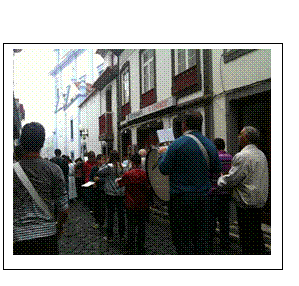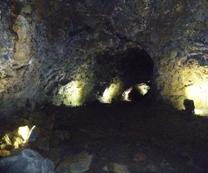Terceira

|
37:44.32N 25:39.84W Yesterday we sailed overnight from Terceira, arriving at Ponta Delgada on Sao Miguel at midday. We left Terceira earlier than intended as we had to vacate our berth and move to the reception pontoon as the marina was full. The swell made it extremely uncomfortable lying alongside, with the boat banging hard onto the pontoon, threatening to burst our fenders, so we cut our losses, abandoned our last meal ashore and fled out to sea. The passage started well and we were able to get the cruising chute up which made the best of a fairly light wind. As night came on however, the wind disappeared and we had to motor for several hours. A light breeze gradually filled in, and we sailed gently along under a starlit sky. We saw the full moon rise, a deep orange colour, changing colour as it rose higher, casting a bright silver light on the sea. John was visited by a large school of dolphins who splashed about in the moonlight – quite magical. Today is a ‘jobs’ day so I have interpreted that as a ‘blog’ day, and will try to capture some of our experiences on Terceira.
The island seems to be in permanent ‘fiesta’ mode. We arrived on Friday, a public holiday, and nothing seemed to be open. This also seemed to apply to Saturday. Sunday, everything was tight shut and on Monday it was another public holiday. Even the restaurants and bars were shut so we were getting a bit pressed for finding ways of feeding ourselves. Throughout this long weekend, we kept on hearing the loud bangs of rockets being fired off. These turned out to be connected to the festival of the Holy Spirit. All over the town, and all over the island there were little chapels, or Imperios, which housed silver crowns and chalices.
These were paraded through the streets, to the accompaniment of a band, sometimes brass, sometimes guitars, sometimes both. At various intervals, the rockets were set off, and the whole parade would occasionally stop outside, for example, the Red Cross society, or some other charitable organisation and sing them a special song prior, I think, to giving them some donation.
Folk dancing and music seems to be part of everyday life on the island, not just a bit of heritage that people are trying to keep alive. Half way through the week, heralded by rockets, we heard a band approaching the marina roadway. With them was a group of perhaps 50 or 60 young people, all dressed in normal clothes, jeans, backward baseball hats etc. singing and doing a sort of progression dance, not unlike a Scottish reel. Also big are the ‘Touradas a Corda’ or street bullrunning, which apparently goes on all summer. We didn’t actually get to see any of these, although we saw some on the television. While driving round the island we kept on coming across mini bullrings or places where they were choosing which bulls to run. There is a large new bullring in Terceira and an enormous statue of three rampant bulls on a roundabout on the ring road which is apparently new. As we were leaving they were preparing for another fiesta, the feast of Sao Joanina,which goes on for a whole week. The tourist office played the whole thing down, saying there was nothing in it for tourists, but as the week drew on, we noticed food and beer tents being put up all over the town, unused buildings being turned into temporary restaurants, shop window displays suddenly started featuring local ‘artesanato’ and big event tents with colossal sound systems went up. Sadly we will not know what a good time was had by all, because we had made our plans and needed to be in Sao Miguel to prepare for our return to the UK. We hired a car for 4 days and managed to see most of the island. We went to the main city, Praia da Vitoria, which was described in the guidebooks as much more lively than Angra. What they meant was that it was much more like Blackpool, although on a smaller scale, so we scuttled back to Angra.
They have four sign-posted trails on the island and we did one of them, on the West Coast, which took us up to a lake called Lagoinha, which lies in a crater. Unlike in England where lakes tend to be in low lying country, lakes in the Azores are found on the tops of mountains, so it took a 500 metre climb to get there, and then a very uncomfortable 500 metres down on paths. The views were spectacular however. From the top we could look over the sea to Sao Jorge, which had not visited and there, peeking over the top, was the summit of Pico, very distinctive with its characteristic cloud part way down from the summit. Beyond, we could just distinguish Faial.
The scenery on the walk was beautifully varied, a lot of it mercifully in the shade of the old, indigenous juniper trees. We walked alongside the bright green, impenetrable Azorean heather and down the side of a fantastically deep gorge.
We treated ourselves to staying in a couple of hotels while on the island. The first was the Quinta das Merces. It was absolutely delightful, a seventeenth century quinta or manor house, with a new wing added on for guests, exactly copying the original structure. Guests were able to use all the reception rooms, which were beautiful, lofty rooms, furnished with exquisite taste; antiques and a certain amount of ‘Chinoiserie’. The owner showed us around the house and the grounds and was absolutely charming. She and her husband had spent some time in Macau and China and Timor. It emerged the next day that ‘Senhor’ had actually been the last governor of Macau, so this was very classy establishment. They had photographs of themselves welcoming the King and Queen of Spain who had hired the whole quinta for their summer holidays a few years previously. They also had the most fabulous infinity pool, filled with sea water, but mercifully heated, so we passed a very relaxing hour or so swimming and reading by the poolside. Regrettably, they only had room for us for one night, so the next night, we booked into a lovely hotel, overlooking the marina. Why, you may ask. Why not just sleep on the boat. Well, the bath was one good reason, and the hotel restaurant was another. Food in the Azores is generally speaking not great. They serve huge quantities of fairly basic food, all served with chips, rice and tinned vegetables, notwithstanding the fabulous vegetables that we see growing all over the island. The hotel restaurant was in a completely different league. Not only was the food sophisticated and moderate in proportion size, but the staff were magnificent. The ‘maitre d’,’ was splendid, all kitted out in silky waistcoat, greeting guests with ‘bonhommie’ and good humour. He was rather put out by our request for Pico wine and suggested a good local Terciera wine which was served by a suitably lugubrious sommelier, no waistcoat, just a black staff apron. Although tipping is not the norm in Portugal, the MD had done us proud, and he had no problem accepting our proffered tip. On our last day on Terceira, we finally made contact with some of the boats that we had been talking to when coming across the Atlantic. In particular, we spoke to the owners of Heimkhier, who had organised the net that we were listening into and who we had spoken to on VHF. They were a very friendly couple, and it was a shame that we were leaving that day and couldn’t talk more. They described their time in Flores, which sounded interesting and certainly ‘different’. It appears that it is not only fog that interrupts flights into Flores, but also the fact that the runway is built at right angles to the prevailing wind! There is a new marina, which is not actually open, but everyone was pouring in there because of the lack of wind and the need to refuel. It was apparently very exposed to ocean swells, and in the high winds that blew up later on, was a very difficult place to stay. We saw Lotus, but unfortunately no one was on board. No doubt they will turn up in Ponta Delgada, other old friends are here, and it will be good to talk if they do. There is something special about contacts made when thousands of miles from anywhere in mid Atlantic. | |||||||||||||||||||||||||||||||||||||||||||||||||||||||||||||||||||||||||||||||||||||||||||||||||||||















